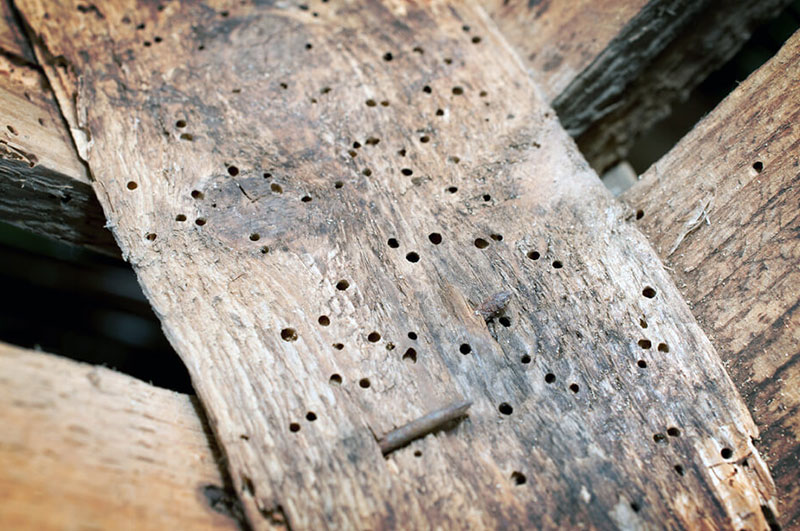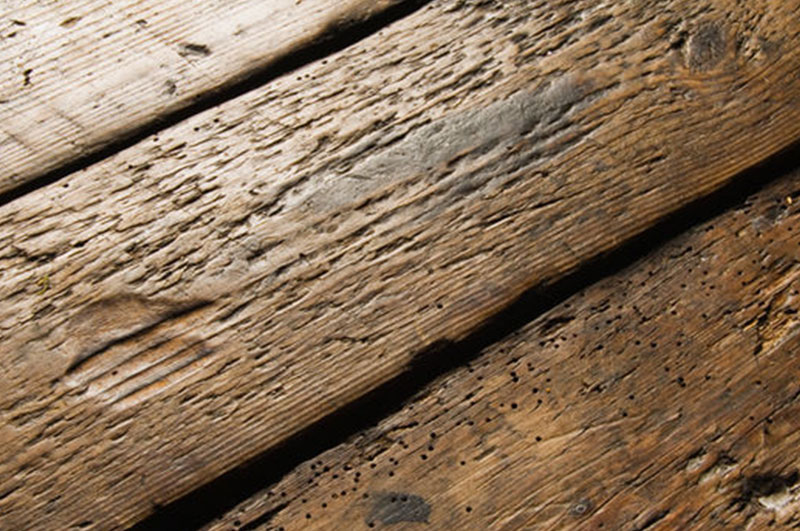email us
call us now
email us
call us now
 Woodworm is not actually a worm. Woodworm is a general term used to describe the wood-boring larvae of an insect. There are various species of insects with wood-boring larvae that can be found in domestic and commercial properties. These larvae are small, white and have a “C-shaped” body. Woodworm larvae stay hidden in timber and they appear only when they are fully grown beetles. The most common species of woodworm is the Common Furniture Beetle (Anobium punctatum). Other species of woodworm much less common in northern England include:
Woodworm is not actually a worm. Woodworm is a general term used to describe the wood-boring larvae of an insect. There are various species of insects with wood-boring larvae that can be found in domestic and commercial properties. These larvae are small, white and have a “C-shaped” body. Woodworm larvae stay hidden in timber and they appear only when they are fully grown beetles. The most common species of woodworm is the Common Furniture Beetle (Anobium punctatum). Other species of woodworm much less common in northern England include:
The experienced and CSRT Certified woodworm treatment specialists at Damp2Dry Solutions, one of the best woodworm treatment company in the UK, has been treating woodworm in properties for over twenty-five years all across Yorkshire.
We are DPA (Damp proofing Association) and IOSH (Institution of Occupational Safety) Certified. Our Damp and Timber treatment work comes with a 20-years guarantee backed with extra peace of mind.
Due to Covid19, we follow all Government guidelines and make sure we still provide woodworm treatment in homes and commercial premises. We take all precautions with regards to social distancing and the use of shielding equipment.
Are you concerned about woodworm in your timbers, floorboards, or furniture? Get in touch with our woodworm treatment expert team, and allow them to survey your property and assist you in determining the best course of action to prevent woodworm and woodlice problems while remaining safe. Just call us on 0148 436 7130 or click on the contact menu or request a woodworm survey
Woodworm life cycle consists of four stages: -
Wood-boring beetles inhabit on detritus (or forest floor) and their larvae feed on rotting forest tree woods. Occupied buildings are generally not a comfortable environment for woodworm. To thrive, woodworm requires a relative humidity above 60%, however, they can often persist in occupied buildings taking several years to complete their life-cycle instead of one. For this reason, woodworms are often found in areas of a building that have chronic damp problems such as poorly ventilated basements, cupboards and roof voids.
As the name common furniture beetle suggests, woodworms are often found in old furniture – especially stored in a damp cellar or outbuilding.
Exit Holes – Or flight holes are small neat fresh round holes approximately one to two mm in diameter with sharp edges. These holes indicate that the woodworm larvae have been present inside the wood for some years feeding and growing to become adults, completing their life cycle by eating their way out of the timber. Unless the timber has been treated there will almost definitely be many more insect larvae active inside the wood.
Bore Dust – Faeces called frass, the debris from the woodworm larvae is an early tell-tale sign of infestation. A cream-coloured powdery material which may feel gritty to the fingers if relatively fresh. This is seen under the infected wood and indicates that the woodworms are currently active. Inside the wood will be a growing network of unseen tunnels and galleries which if left untreated will weaken and damage the wooden structure of a building.
Woodworm Larvae – The adult female of the common furniture beetle lays her eggs in cracks, crevices or existing flight holes in timber. The tiny pearl-like woodworm eggs are barely visible to the naked eye so usually go unnoticed. Within a few weeks, the tiny larvae hatch and baby woodworms immediately burrow into the wood where they live for two to five years feeding, growing and causing structural damage to the timber. These larvae are the actual woodworms. They are greyish white with a narrow dark band over the mouthparts and grow to about 6 mm long. The front part of the body appears relatively thick or hunched and has three pairs of visible legs. The rear section of the body is thinner, with a rounded tail-end.
Adult Beetles – Small brown beetle between 3-6 mm long – like most beetles they fly, so can easily move around and enter buildings. The adult beetles emerge from infested timber in the spring between May to August. The female beetle seeks out a suitable timber for the woodworm larvae to feed on and the male then finds the female by tracking the pheromones she releases. The adult beetles mate and then soon die without causing further damage to timber. Dead adult beetles are a common sign of an active woodworm infestation.
 Woodworm
Woodworm Woodworm
Woodworm Woodworm
Woodworm Woodworm
WoodwormAny woodworm treatment starts with understanding the problem and the clients’ requirements. That is why we first offer a woodworm and damp survey. Our expert will visit and take the time to understand your situation, explain & discuss the woodworm treatment solutions available. We can then propose the most cost-effective, guaranteed solution that is right for your property.
Landlord, homeowner, or commercial property manager we understand that each client and each property is unique. At Damp2Dry Solutions (Yorkshire) Ltd., we offer more than just pest control, we offer a guaranteed total solution to ensure that not just the woodworm is treated but also our experts can investigate and treat the damp conditions that cause woodworm, other insect infestations and the associated problems.
Most woodworm infestations treatment typically involves spraying the affected timbers with an insecticide which eliminates beetles and larvae. With most sprays, treated homes can be reoccupied that same day.
Our woodworm treatments use the latest water-based insecticides to minimize any risk to occupants. We also offer woodworm treatments in the form of a liquid, paste or gel, applied by brush or injection as required. For example, should we find a deep-seated deathwatch beetle infestation, our woodworm experts will use a deeply-penetrating insecticidal gel. Timbers which have been severely affected by a woodworm infestation may become structurally unsafe, so treatment may include cutting away and replacing infected timbers or repairs with specialist epoxy resin products.
There are many factors to consider before undertaking a program of woodworm treatment so it is important to seek independent expert advice from a reputable company. Inspection and the subsequent program for woodworm treatment should include:
West Yorkshire- Batley, Bradford, Brighouse, Castleford, Cleckheaton, Dewsbury, Halifax, Hebden Bridge, Holmfirth, Huddersfield, Ilkley, Keighley, Leeds, Morley, Normanton, Ossett, Otley, Pontefract, Pudsey, Todmorden, Wakefield, Wetherby, Yeadon
East Yorkshire- Bridlington, Beverley, Driffield, Goole, Hedon, Hessle, Hornsea, Howden, Kingston upon Hull, Market Weighton, Pocklington, Withernsea
South Yorkshire- Sheffield, Rotherham, Barnsley, Bawtry, Dinnington, Doncaster, Hatfield, Mexborough, Penistone, Wombwell
Contact a leading woodworm treatment company in Yorkshire, Damp2Dry Solutions to help you protect your property from woodworm problems. We do not offer one size fits all in woodworm treatment. We are driven by complete customer satisfaction. To achieve this, we have a range of treatments, some exclusive to our company, combined with our expertise and understanding we deliver total solutions. Our solutions are crafted to the needs of our clients, their buildings and the occupants of those buildings and are guaranteed, long term and cost-effective.
For any help and advice regarding woodworm treatment and our services, feel free to get in touch with our professionals by calling 0148 436 7130 or request a survey.